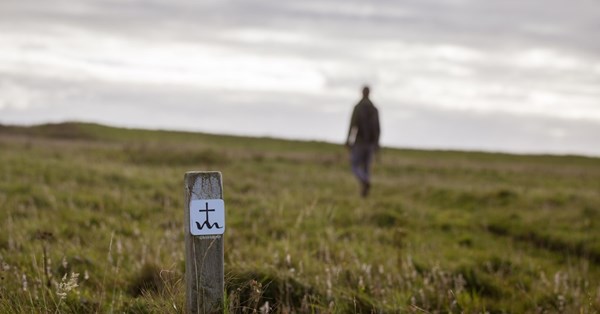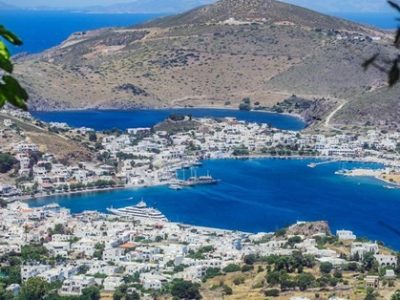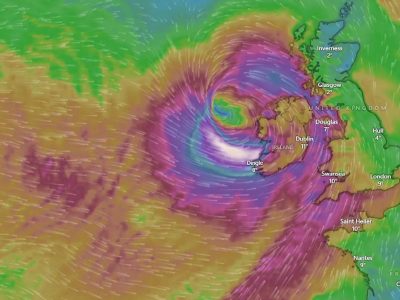PILGRIMAGE — along with midnight mass, cathedral evensong, and the latest Charismatic church-plant in a town near you — is a trend-bucker amid the general picture of religious decline in the UK.
The British Pilgrimage Trust website lists dozens of options, from one-day explorations of a cathedral to substantial long-distance routes. They tap into several factors, such as beautiful countryside, historical links, archaeology, old churches, and cosy pubs, about which there is little not to like.
Is modern-day pilgrimage, therefore, just something of a well-being fad; a pleasant way for the leisured class to give meaning to their rambling? Or might going on pilgrimage still retain its ancient ability to lead one on a journey that, while signposted outwardly, leads one into uncharted terrain inwardly? Only one way to find out. . .
Mainland Orkney is one of more than 70 islands and skerries in the Orkneys, 20 of which are populated. Getting there is, perhaps, part of the pilgrimage.
Certainly, by the time my NorthLink Ferries vessel from Scrabster, on the north coast of Scotland, rounds the Old Man of Hoy, on the west coast of Hoy, I feel as though I am entering another world, whose light-washed skies seem to open up the possibility of personal change that I think has always drawn people to pilgrimage.
St Magnus Way, on Orkney Mainland, is dedicated to Magnus Erlendsson, Earl of Orkney — an influential trading and military outpost of the Norse (Scandinavian) kingdom at the end of the 11th century. He shared leadership with his cousin Haakon Paulsson, but the partnership fractured and civil war ensued.
A peace forum was arranged on the small island of Egilsay, in 1117, each earl to be accompanied by two boats of supporters and supplies. Haakon arrived with eight.
Magnus, for whom Christianity was a central influence, offered to self-exile, to enable a united Orkney to flourish in peace. Instead, an axe was sharpened, and Haakon’s cook was ordered to do the killing, when others demurred. Magnus presented himself for the fatal blow while praying for his executioner’s pardon.
The subsequent remorse and penitence of Haakon and the canonisation of Magnus in 1136 coincided with a period of prosperity and peace for the Orkneys that, in the context of those sea-trading times, was well placed to thrive.
The St Magnus Way, established in 2016, follows the route of Magnus’s body from Egilsay, where he died, to his place of burial at Birsay, in the far north-west of Orkney Mainland, and thence to the impressive St Magnus Cathedral, in Kirkwall, built about two decades later to safeguard his now hallowed relics.
The first stage entails catching Orkney Ferries’ small ro-ro ferry from Tingwall, on Orkney Mainland (“re-ro” would be more accurate: the few farm vehicles and cars reverse on, and roll off). Egilsay is a request stop on this three-island route (Rousay, Egilsay, and Wyre), and the pilgrim’s hours spent there are likely to be in solitude.
On Egilsay, in a squelchy field, there is the St Magnus cenotaph, set up in 1937 to mark the traditional site of the martyrdom of Earl Magnus, and a 12th-century ruined church of St Magnus. A community centre, left open and unattended (something that is remarkably true of many public buildings along the route) provides shelter, refreshment, and table tennis.
The fluting calls of curlew and the busy roistering of oystercatchers as I walk here, soon establish themselves as the Way’s regular soundtrack.
On Orkney Mainland, the rest of the Way is arranged in five stages, each about ten to 12 miles, following tracks, quiet roads, and paths along the shoreline and clifftops, across farmland and open moor.
A keen walker could combine stages, but the appeal of pilgrimage is to allow the journey to get under the skin. I drink in the close-cropped grassland, the meditative tedium of the slow-moving wide horizons, and the constant background wash of the sea.
 Alamy St. Magnus’s, Egilsay, which marks the beginning of the 58-mile St Magnus Way
Alamy St. Magnus’s, Egilsay, which marks the beginning of the 58-mile St Magnus Way
With each day’s walk, I become more and more struck by the story of Magnus: his striving to combine faith and political leadership; his being, literally, at the cutting edge of political and internecine strife, making him a saint worthy of contemplation in our troubled times.
Along the way, I feel prayerfully drawn to echo Magnus’s yearning for peace in his time amid the conflicts (apparently so obdurate and hopeless) in the news — also too often witnessed in our churches, and those that rage within ourselves.
I reflect, too, on my constant struggles as a priest: how to love people, but how to express that love also by administering a parish well (I may be willing to devote time to the needy drug addict, but overlook the organist’s deserving the hymn numbers in advance of a service).
At times, I wonder why I am doing this walk: when it pours, when I’m tired, and when my thoughts run wildly away from me, like the hares that spring up so unexpectedly along the route.
 Alamy St Magnus Cathedral, Kirkwall, where the pilgrimage ends in splendour
Alamy St Magnus Cathedral, Kirkwall, where the pilgrimage ends in splendour
Such questionings are perhaps part of the point. We go on pilgrimage not only to get away, but to come home — to ourselves, and to our circumstances — with a renewed sense that change is necessary and possible, and that peace and forgiveness, no matter how unlikely, are none the less to be striven for.
The last few miles are a painful, slow, but expectant, trudge.
My entrance, at last, into the extraordinary cathedral in Kirkwall, late on a grey Friday afternoon, is memorable: the series of Norman arches a solid presence, humbling yet reassuring.
I kneel — as I feel moved to do in the roofless church on Egilsay, and amid the Benedictine remains on the tidal Brough of Birsay — and pray the words that the theologian and poet Gilbert Markus has used to address Magnus:
You psalm-singer in the arrow storm,
Firm-footed in the hour of blood. . .
Where violence is done,
Teach us to stand firm,
Teach us to stand clear and cry your cry:
“I have no quarrel with anyone here.”
Show us your path of peace.
Bright Magnus, pray for us.
An organist in the cathedral, pausing from his practice, kindly directs me to the site of St Magnus’s relics, indicated (with Presbyterian reserve) by a simple plaque. The custodian, whose office is close to the pilgrims’ corner, smilingly presents me with my pilgrim’s certificate.
The cathedral is soon to close; so I find the Bothy Bar near by, settle with a pint of Orkney ale, and consider my pilgrimage “credential”. Its concluding words sum up my journey perfectly (perhaps all pilgrimages, wherever and however taken):
Each step brings peace closer,
every breath is a new found song.
The Revd Philip Martin is the Vicar of St Aldhelm’s, Branksome, in Poole, Dorset.
Travel details
Following the route is straightforward, thanks to signage and a free app. A printed guide is available from bookshops and tourist offices. In addition, I carried the Landranger Ordnance Survey map 6.
Accommodation should be arranged in advance. Wild camping is permitted, but Orkney is rugged, and sheltered spots are rare. There are only two or three pubs en route, other than in Kirkwall; the only café I noticed was in Birsay.
From a base such as Kirkwall, Finstown, Dounby, or Birsay, one can access the start and finish of each stage using the excellent (and cheap) bus services.
In coming to understand Magnus himself, historical context and continuing relevance today, most helpful to me was the novel of the same name by George Mackay Brown, available online and in bookshops in Stromness and Kirkwall.










